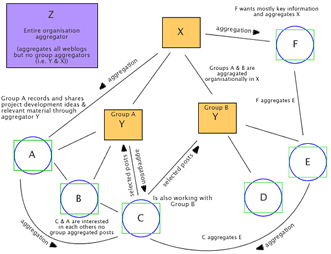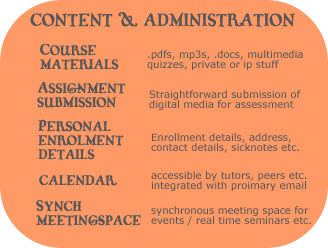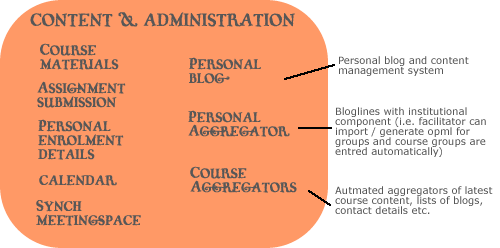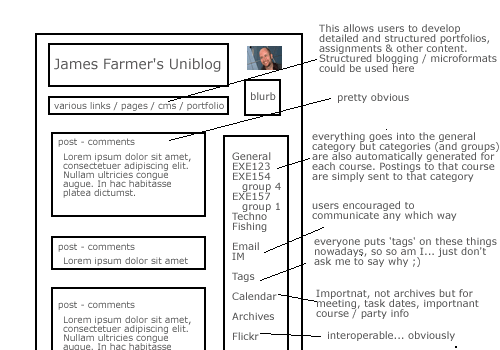 Seems like there’s a big wave ‘o people talking about PLEs in some pretty major terms.
Seems like there’s a big wave ‘o people talking about PLEs in some pretty major terms.
Stephen, for example, says this:
It’s just you, your community, and the web, an environment where you are the centre and where your teachers – if there are any – are your peers. It is, I believe, the future – and where, one day, the next generation of Blackboards and WebCTs and Moodles and Sakais will make their mark
Derek interviews Oleg Liber who provides a fascinating insight and should be a definite read / listen (although I *strongly* disagree about the efficacy of a desktop based environment, but that’s another story).
Terry is absolutely going off on one as well:
The PLE is a unique interface into the owners digital environment. It integrates their personal and professional interests (including their formal and informal learning), connecting these via a series of syndicated and distributed feeds…
But what really got me tapping is this:
Although there is something quite compelling about the vision of a lifelong learning environment that is centered upon and perpetually belongs to the learner, I think we are some distance from being able to operationalize that vision.
As I’m not sure I agree. In fact, I reckon that right now we’re limited pretty much only by our imagination and ambition, and in tools like Elgg and WPMU we’re not far off cracking it. Yeh, major institutions aren’t going to start switching their LMSs to our PLEs any time soon and yes security, ip, maturity and (above all IMO) the structuralist transmissive models that LMSs on the whole play up to and re-enforce make this a difficult journey, but having said all that…. stranger things have happened.

I think that there are essentially only two key components that you need for the kind of online learning environment / tool (another good Liber point, are they really environments) and these are content/admin and communication. In the first instance (as you can see on the diagram) I reckon content/administration essentially comes down to course materials, assignments submission (this can be submitting a link too… just that it’s that ‘official’ step), personal enrolment details like address / contacts etc., calendar functionality for group organisation and a synchronous meeting environment for organised group or class get-togethers.
Not so exciting so far but do give me a moment….

This is of course the good stuff… three links essentially to a fully featured personal blog / Content Management System, a personal aggregator (which would, of course, simply opml export to your aggregator of choice) and some course aggregation features so that you could quickly browse latest postings in your course, details of teachers and students and other useful stuff like that :) Naturally all of these links would be database driven and pretty much entirely pre-populated with the exception of the capacity for teachers to prepopulate areas of personal aggregators either manually or automatically based on groups (there’s a group generator behind this as well… you just haven’t seen it yet ;)
Still not convinced? Well, OK then, assuming that the personal aggregator can be pretty much explained as Bloglines-esque (there are plenty of open source aggregators that could fit this mould) and that the course aggregation is simply a matter of automatically aggregating particular information (and posts of course) into various categories based on a few meta-tags (that will have been automatically inserted through enrolment details) then the real juicy bit is of course the blogging system whereby your learner actually ‘learns’ through the creation and development of posts, the linking, synthesising and pinging of other posts and by commenting on yet more posts on other blogs. So how do they do this? Well…

So, with this kind of blog the categories are automatically generated by the metadata of the students enrolment and they can then, nice and easily, post to that course (and / or the group which they are part of in that course). And if they want to view other postings in that group, or general information, or course material (if they’re authenticated… which they will be) then all they have to do is click on that course link and they’re there. Bingo.
Naturally they also are able to use this for posting about other stuff (they can just create another category or use their general one), creating assignments and all sorts of digital media, developing portfolios (now there’s a possible cool use of structured blogging!) and all that other stuff.
So for a teacher they simply prepare their course content, dates etc, and figure out what tasks / activities and deadlines they;re going to use (nothing more than a regular course really). They then facilitate by posting on their own blog (they can also mass email users / post news of the course aggregator… just to get the message home) and commenting on learners. Easy peasy.
For students they have their blog from day 1 and for each course they do they post to the relevant category and interact with other students and the teacher either through that or through linking. They’re able to refer to previous postings in future courses, demonstrate learning, develop some *serious* digital literacy and a fair bit more.
And of course, it incorporates subversion left right and frickin centre.
“But James, you’re dreaming, who’s gonna build this thing? Who’s got the time? The money?” I hear. Well, it could just be the schizoid paranoia but I’m taking a guess that it’s the wolves of blogland coming to trounce my amateurish and naive idea.
Not so I say. In fact I’ve been leading you down a bit of a garden path (sorry) in suggesting that there I’m talking about two separate environments here. Because in fact I’m not, I know one that only needs some tweaking and a bit of programming and you’ve got exactly what I describe above.

Check it out… WordPress as represented in WPMU has a very very powerful space called a ‘Dashboard’. This is where your content and administration sits, or, at the very least the links to the relevant courses content as uploaded in some simple system that your IT guys put together in 25 minutes. Assignments submission is simply a matter of a form and a drop-select (and add in some nice things like retrieve and edit and you’re really laughing), personal enrolment details can be represented and edited from here as easily as they can anywhere else. There’s no shortage of open source calendars if you’ve got a little time to fix ’em up and of course you can use and link in whatever synchronous environment you want. As for personal and course aggregators… the potential in tools like Gregarius and FeedWordPress is pretty huge too.
So there we go. Do you fancy one?
James,
Maybe is naive, maybe is just a dream, but I think you hit the point.
I agree with you!
Thanks for your suggestion :-)
Stefano
Well, you know what James? This is how I’ve been pretty much already doing it (with our incsub.uts weblogs) – still needs a little more tweaking but…there ya go!
Oh – I prefer to allow the students to generate their own categories…have you ever tried to use a filing system inflicted upon you…can’t find a thing! When I use my own labels/categories I know exactly where everything is!
Watch out for some more details of my PhD findings re the variations in development of knowledge through this process – early analysis of data is looking really interesting!!!
Oh – digital literacy is still a challenge – for me too…without IT support (I’m not a programmer) “tweaking” any codes puts me into a cold sweat!
Aren’t I lucky I’ve got you to look after me!!! ;-)
ABB
Not only is this an ‘inevitability’ it’s probably for a lot of students already something they’re essentially using in their daily lives anyways. The fact that someone starts structuring something like a PLE specifically for learning is a no-brainer as far as i’m concerned. Thank-you, thank-you, thank-you … for the Gregarius link … i’ve been looking for something like this and was almost about to start programming it myself.
Posted for Stephen Powell who can’t for some reason (if you have problems posting comments contact me https://newincorg3.wpmudev.host/contact-me/ and letr me know as I need to fix it asap)
“Hi James, reading through the post there is little of significance that I
would disagree with on a philosophical level, however there is one point
where sadly I think your optimism overtakes what will actually come to
pass unless there are some compelling reasons to change, and there might
be…
“Yeh, major institutions aren’t going to start switching their LMSs to our
PLEs any time soon and yes security, ip, maturity and (above all IMO) the
structuralist transmissive models that LMSs on the whole play up to and
re-enforce make this a difficult journey, but having said all that….
stranger things have happened.”
I don’t think this will happen for several reasons:
1. Lecturers, professors, instructors (call them what you will) are by and
large conservative and timid beast and anything that smacks of a loss of
‘control’ will be railed against
2. Administrators in HE institutions far from seeing ICT and the web as
enabling and empowering actually see the technology as a means of
controlling and capturing.
3. The majority of students have had a life time of being told what to do,
how to do it, and when to do it. This brave new world articulated as
‘lifelong learning’ is not a particularly appealing place for many as it
means we have to take responsibility for ourselves!:^)
So where does this leave me, well all I can do is try to make a
difference. I can set up the programmes, enthuses about the technology,
and generally put my shoulder to the wheel of a lumbering cart that is
change in Higher Education.”